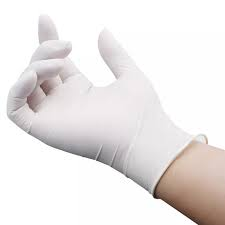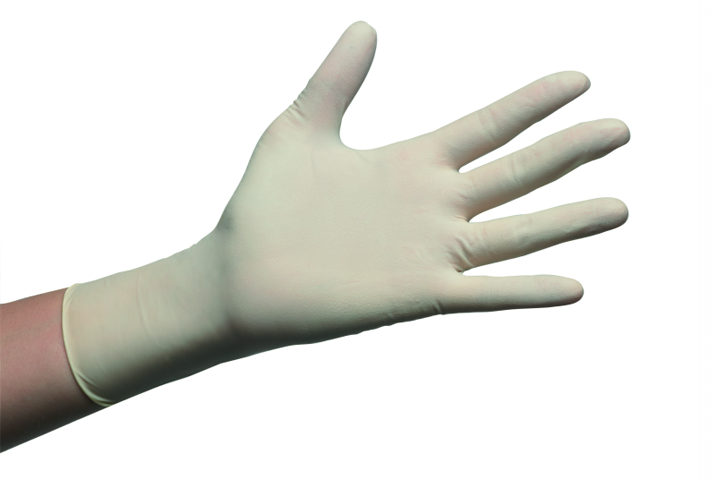2021/08/23 / By hqt / Tags:
Two Popular Types of Powder-free Latex Gloves on the Market
Latex examination gloves are popular products in many fields from medical, food to laboratory. There are many types of medical gloves of which powdered medical gloves are the most common. Why add powder to medical gloves? What are the benefits of powder-free medical gloves? This article will answer these two questions.

The problem with powdered latex examination gloves
The first these gloves produced were powder-free. However, due to latex rubber (with high friction), the gloves are difficult to put on and take off. So NSX adds powder to the glove to reduce friction between the glove and the hand, thereby making it easier to put on.
However, latex examination gloves also have some disadvantages:
In a low-humidity environment, the powder in the latex examination gloves will absorb moisture on the skin of the hands, causing the skin to dry out. When preparing food, the powder in the gloves can be released into the food. Some people are allergic to the protein in latex rubber (common symptoms are itching, swelling, redness, etc.)
If you can accept the above disadvantages then continue using powdered gloves. But if you experience an allergic reaction, stop using it and contact the supplier for advice on suitable replacement products.
Types of rubber materials common to make latex examination gloves:
Ø Latex rubber
Nitrile synthetic rubber, extracted from petroleum. In addition to nitrile, other synthetic rubbers such as vinyl and neoprene are also common to produce gloves. However, because it does not meet the technical requirements (vinyl) or the price is high (neoprene), it is not selected to produce medical gloves.
Ø Latex powder-free medical gloves
The most common reason users decide to forgo powdered latex examination gloves is an allergy problem to the proteins in the latex. So the problem here is the protein in the latex.
How to deal with allergy problem?
To overcome this drawback, NSX gloves use one of two ways:
Ø Method 1: dip in chlorine solution
As a result, the amount of protein in rubber is significantly reduced. There by eliminating the risk of allergic reactions almost completely. And then came out Chlorine medical gloves. In addition to the use of protein extraction, this method also reduces the stickiness and friction of rubber easier to wear gloves. However, the downside is that the rubber color is slightly yellow.
Ø Method 2: polymer coating
The polymer layer separates the skin of the hands from the rubber => eliminates the risk of allergies. In addition, the polymer layer is slippery so it is easier to wear gloves.
Latex examination gloves without powdered rubber nitrile
Nitrile is a synthetic rubber, so it does not contain the protein of latex rubber. Using nitrile latex examination gloves completely eliminates the risk of causing an allergic reaction. However, the nitrile rubber surface still has a high level of friction, making it difficult to wear gloves.
Therefore, in order to make the gloves easy to wear, two methods of manufacturing powder-free latex gloves can also be applied in this case.
Why nitrile rubber gloves have not been able to completely replace latex examination gloves?
That's because nitrile gloves are inferior to latex gloves in terms of elasticity and grip. Grip feel is a very important element of medical gloves common in surgery. In order to have precise manipulations, the surgeon requires a very high sense of grip. Currently, nitrile medical gloves are mostly common as examination gloves.
Another reason is that latex examination gloves are more expensive than latex gloves (by 20% or more depending on weight/piece). For manufacturing and processing enterprises, this is an issue to consider.
The future of powder-free medical gloves
Latex and nitrile powder-free medical gloves have many advantages. However, the price disadvantage makes them not yet able to replace powdered medical gloves. Until the price issue is resolved, perhaps the best solution is to use both powdered and non-powder gloves in parallel.

The medical glove market has not only 1-2 types but is quite diverse in terms of types and manufacturers. Besides powdered medical gloves, there are other types of medical gloves such as: chlorine-free medical gloves, powder-free nitrile medical gloves...
Pros and cons of powdered latex examination gloves
One of the biggest advantages of powdered latex examination gloves is that they are easier to put on and take off. Imagine you work in a hot and humid environment, your hands sweat a lot, the powder in the gloves will absorb sweat from your hands and make putting on and taking off gloves much less strenuous.
Disadvantages of latex examination gloves
- In dry, low-humidity environments, the powder in gloves can cause the skin to dry out.
- If not stored in the right environment (low humidity), the powder in the gloves will easily clump.
- During food processing, the powder in the gloves can be released into the food.
- Some people experience itching or redness when using powdered gloves.
Two popular types of powder-free gloves on the market:
- Chlorine-free gloves (latex rubber)
- Neoprene gloves (nitrile rubber)
Ø Chlorine “powder-free” medical gloves (latex)
Why is "no flour" in quotes? That's because although it is called "no powder", in fact there is still a very small amount of powder on the glove.
Ø Where does this little powder come from?
Chlorine-free gloves are latex examination gloves that have been "washed" with chlorine. This process helps to remove most of the powder on the glove. The amount of powder left on the gloves is very small and safe for users. According to the US FDA , medical gloves with a powder content of less than or equal to 2 milligrams per glove are considered "powerless" gloves.
Ø Advantages
- Easy to put on and take off gloves
- “Powder-free” (according to FDA standards)
- Does not cause allergies
Ø Disadvantages
- Slightly yellow color
- Smells like chlorine
- Relatively high price
Summary
The green neoprene gloves come with better material included design technology to reduce the muscular effort that comes to cause stress in the joint area of the arm. This surgical glove was subjected to additional tests and to have a low risk of irritation during intraoral interventions. It also offers a secure grip and allergy protection.


